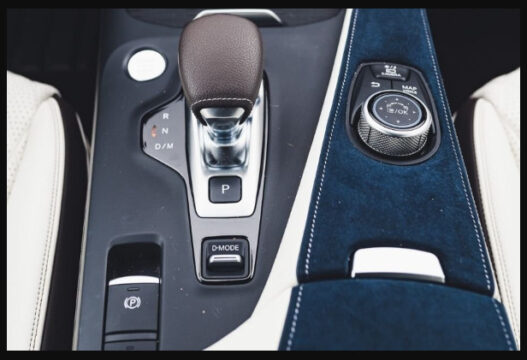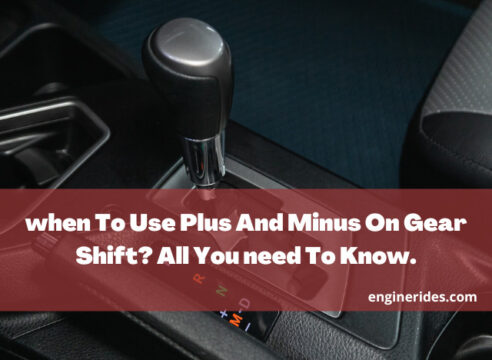when To Use Plus And Minus On Gear Shift? All You need To Know
In this article, we’ll explore when and how to use the plus (+) and minus (-) options on your gear shift. Whether you drive a vehicle with an automatic transmission equipped with manual mode or a vehicle with a dedicated manual transmission, understanding how to engage these options effectively can enhance your driving experience and provide greater control over your vehicle’s gears.
Read on to discover the ins and outs of using the plus and minus on your gear shift for a more informed and confident driving experience.
Table of Contents
What are the plus and minus on gear shift?

The plus and minus signs on a gear shift, often referred to as the gear selector or gear shifter, are typically used in vehicles with automatic transmissions or semi-automatic transmissions (sometimes known as “manual mode” or “tiptronic”).
The plus sign (+) is used to upshift gears, which means moving to a higher gear, while the minus sign (-) is used to downshift gears or move to a lower gear. This manual control allows drivers to override the automatic gear selection when more control is needed, such as for acceleration, engine braking, or specific driving conditions like slippery roads or towing heavy loads.
When and how to use plus and minus on gear shift?

Using the plus (+) and minus (-) signs on your gear shift, often found in vehicles with automatic or semi-automatic transmissions, allows you to manually control the transmission’s gear selection. Here’s when and how to use them:
When to Use Plus and Minus on Gear Shift?
Upshifting (+)
- Acceleration: When you need to accelerate quickly, like passing another vehicle or merging onto the highway, upshift to a higher gear to access more engine power and speed.
- Reducing Noise and Vibration: Upshifting can reduce engine noise and vibrations, enhancing comfort while cruising on the highway at a steady speed.
- Fuel Efficiency: Upshifting can improve fuel efficiency by reducing engine RPM when driving at a constant speed.
Downshifting (-)
- Brakeless Deceleration: To slow down without using your brakes, downshift when going downhill. This engages engine braking, preventing overheating of your brakes.
- More Power: Downshifting is useful when you need more engine power, like when towing a trailer, driving in snow, or going uphill.
- Vehicle Control: In slippery or off-road conditions, downshifting provides better control over your vehicle by delivering more torque to the wheels.
Dodge Ram Misfire No Codes; What Should You Do?
enginerides.com
How to Use Plus and Minus on Gear Shift?
Upshifting (+)
- Ease off the accelerator pedal slightly to reduce the load on the engine.
- Move the gear shift lever to the next higher gear (e.g., from “D” to “D+” or “4” to “5“).
- Gradually release the accelerator pedal as you complete the shift.
Downshifting (-)
- Fully press the clutch pedal (if you have a manual transmission) or move the gear shift lever to the next lower gear (e.g., from “D” to “D-” or “4” to “3“).
- Release the clutch pedal slowly and smoothly (for manual transmissions) or allow the transmission to engage the lower gear (for automatics).
Remember, only upshift or downshift when the engine RPM is within the safe operating range, which is typically displayed on the tachometer. Practice these maneuvers in a safe environment if you’re new to manual shifting, and use them to enhance your control and performance based on driving conditions.
Should I drive in D or S?

Whether you should drive in “D” (Drive) or “S” (Sport) mode depends on your driving preferences and the conditions you’re encountering. Here’s a general overview of the differences:
D (Drive) Mode
- Default Mode: This is the standard operating mode for most automatic transmissions.
- Fuel Efficiency: In “D” mode, the transmission will aim to maximize fuel efficiency by shifting gears at lower RPMs, which can help save on fuel costs during normal driving conditions.
- Smooth and Comfortable: “D” mode provides a smoother and more relaxed driving experience, making it suitable for everyday driving, city commuting, and highway cruising.
S (Sport) Mode
- Sportier Performance: “S” mode is often used for sportier driving or when you want more responsive acceleration and engine performance.
- Higher RPMs: In “S” mode, the transmission holds onto gears longer, allowing the engine to rev higher before shifting. This can provide quicker acceleration and more engine braking when slowing down.
- Manual Control: Some vehicles with “S” mode also allow manual control of gears, typically through paddle shifters or a +/- selector on the gear lever. This gives you more control over gear selection.
When to Use Each Mode?
Use “D” Mode When
- Driving in normal, everyday conditions.
- Seeking better fuel efficiency during regular commuting.
- You want a smooth and comfortable driving experience.
Use “S” Mode When
- You want more responsive acceleration, especially for overtaking or merging onto highways.
- Driving on hilly terrain where engine braking may be helpful.
- You want a sportier driving experience or plan to engage in spirited driving.
Ultimately, the choice between “D” and “S” modes should align with your driving goals and your road conditions. Many drivers use “D” for everyday driving and switch to “S” when they want a more engaging driving experience or need additional power. It’s a good idea to consult your vehicle’s owner’s manual for specific guidance on how the “S” mode operates in your particular vehicle, as features can vary between manufacturers and models.
What is B and S in automatic car?
In an automatic transmission-equipped vehicle, “B” and “S” represent two different driving modes or settings that can influence the transmission’s behavior:
B (Brake) Mode
The “B” mode is often referred to as the “Brake” mode in some vehicles, particularly in older or simpler automatic transmissions. In “B” mode, the transmission operates with increased engine braking.
This means that when you release the accelerator pedal, the transmission downshifts more aggressively, helping to slow down the vehicle without relying solely on the brakes. It can be useful when driving downhill or when you want more control over your vehicle’s speed without excessive brakes.
Does A New Transmission Increase Value? All You Need to know
enginerides.com
S (Sport) Mode
The “S” mode stands for “Sport” mode and is found in many modern automatic transmissions. In “S” mode, the transmission is configured for sportier driving characteristics. It typically holds gears longer, allowing the engine to rev higher before shifting to the next gear.
This results in more responsive acceleration and engine braking, which can be beneficial when you want a sportier driving experience, need quick overtaking power, or are navigating hilly terrain. Some vehicles with “S” mode also offer manual control, allowing the driver to manually select gears using paddle shifters or a +/- selector for even greater control over gear changes.
The availability and function of “B” and “S” modes can vary between different makes and models of vehicles. It’s essential to consult your vehicle’s owner’s manual for specific information on how these modes work in your particular vehicle and any manufacturer-specific features or recommendations for their use.








2 Comments